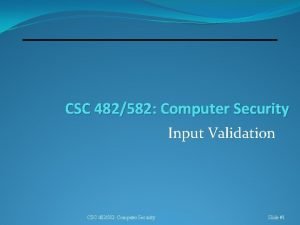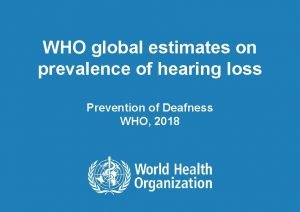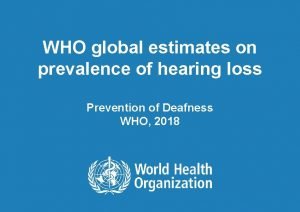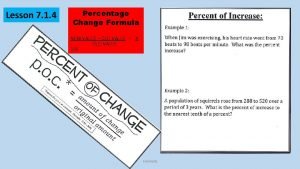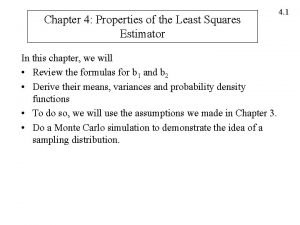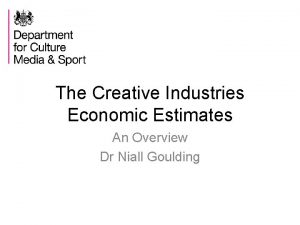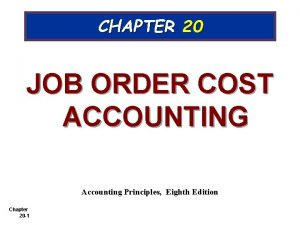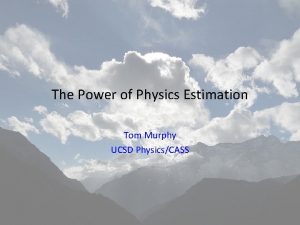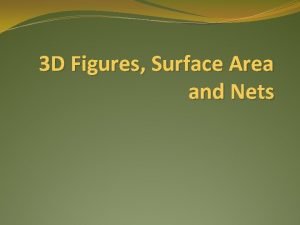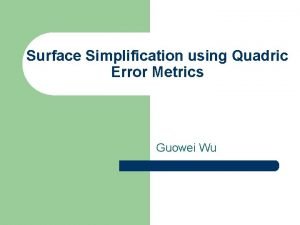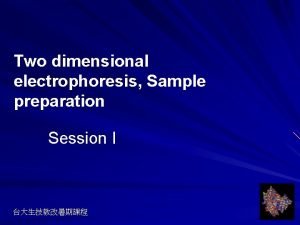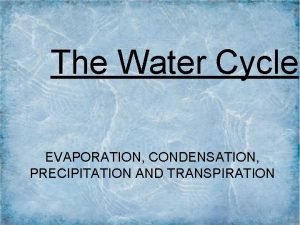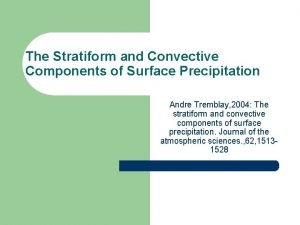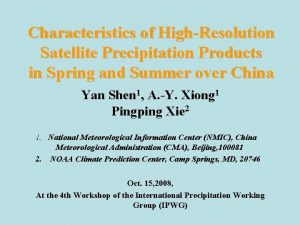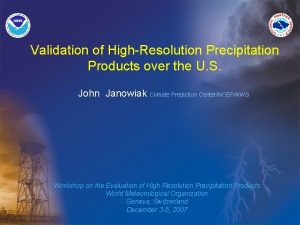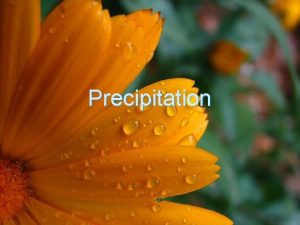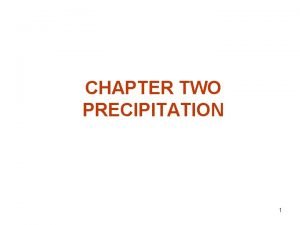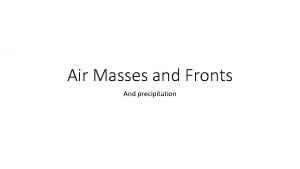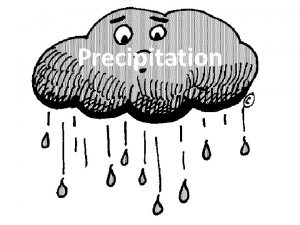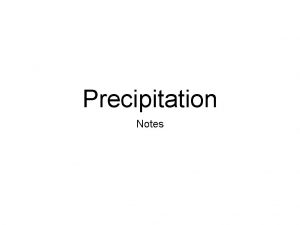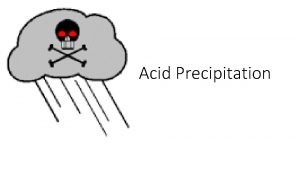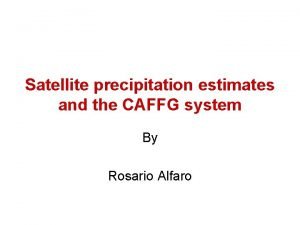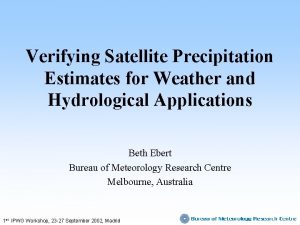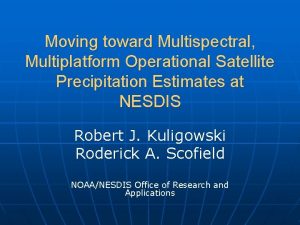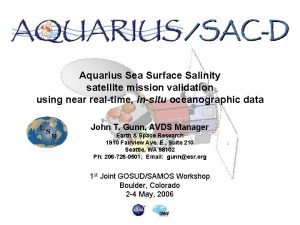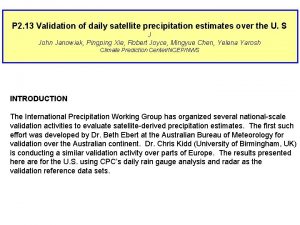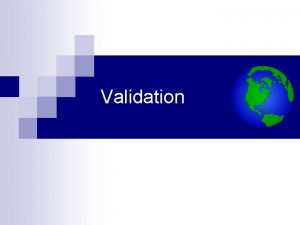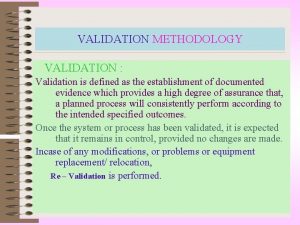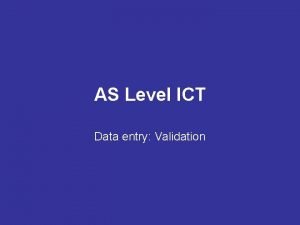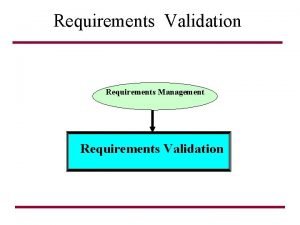Validation of Satellite Precipitation Estimates using HighResolution Surface

























- Slides: 25

Validation of Satellite Precipitation Estimates using High-Resolution Surface Rainfall Observations in West Africa Paul A. Kucera and Andrew J. Newman NCAR/RAL Workshop on the Evaluation of High Resolution Precipitation Products 3 -5 December 2007 2/20/2021 1

Operational Summary for NAMMA • Location: Western Senegal, Cape Verde Islands and adjacent ocean. • Time Period: 21 August – 30 September 2006. • A total of 20 precipitation events were observed during the experiment. • A variety of instruments were deployed in Senegal to measure precipitation: – NPOL 10 cm Polarimetric Doppler Radar – A network of high resolution rain gauges (38) – Two video disdrometers 2/20/2021 2

NPOL Radar • NASA 10 cm (S-Band) Polarimetric Doppler Weather Radar. • Deployed in Kawsara, Senegal (40 km SE of Dakar). • Scanned with a 15 min temporal and 200 m spatial res to a max range of 150 km. 2/20/2021 3

Rain Gauge Network in Senegal • Large Scale Network – 18 gauge sites were deployed to provide areal and range dependent coverage for NPOL. – Provide ground verification data for evaluation of satellite and radar rainfall estimates. – Deployed in June 2005. 2/20/2021 4

Rain Gauge Network in Senegal • Dense Scale Network – 20 rain gauge sites were deployed to examine small-scale rainfall variability. – Deployed in August 2006. – Both networks continue to be deployed. 2/20/2021 5

Seasonal Rainfall Variation for 2006 2/20/2021 6

Precipitation Events Observed by NPOL • • • Event 1: 24 -25 Aug 2006 Event 2: 25 Aug 2006 Event 3: 26 Aug 2006 Event 4: 27 -28 Aug 2006 Event 5: 29 Aug 2006 Event 6: 30 -31 Aug 2006 Event 7: 01 -02 Sep 2006 Event 8: 02 Sep 2006 Event 9: 03 Sep 2006 Event 10: 05 -06 Sep 2006 2/20/2021 • • • Event 11: 07 -08 Sep 2006 Event 12: 11 Sep 2006 Event 13: 13 -14 Sep 2006 Event 14: 14 -15 Sep 2006 Event 15: 19 Sep 2006 Event 16: 22 Sep 2006 Event 17: 26 Sep 2006 Event 18: 27 Sep 2006 Event 19: 28 Sep 2006 Event 20: 29 Sep 2006 7

Time Series of Precipitation Area Observed by NPOL 2/20/2021 8

Radar Rainfall Products • NPOL data were QC’ed to remove ground clutter, second trip, side lobes and other non-meteorological echo. – A + 2 d. B bias correction (based on TRMM PR comparison) along with a ZDR correction was applied to NPOL data • Radar rainfall maps were created using NPOL reflectivity mapped to a 5 km horizontal grid at an altitude of 2 km. • Rainfall maps had a temporal resolution of 15 min. • Reflectivity data were converted to rainfall rates using a Z-R derived from co-located disdrometer data: – Z = 148 R 1. 4 – Polarimetric-based algorithm is currently being developed. 2/20/2021 9

Satellite-Rainfall Comparisons • Radar rainfall estimates were averaged to the 0. 25 x 0. 25 deg grids and accumulated to 3 h resolution. • Comparisons were made with the following algorithms: – – TRMM Multi-satellite Precipitation Analysis (TMPA) CPC Morphing technique (CMORPH) NRL-Blended (NRLB) Precipitation Estimation from Remotely Sensed Information using Artificial Neural Networks (PERSIANN) – Hydro. Estimator (HE) (Was not analyzed because of problems with the product files) • The high resolution products (0. 10 deg x 1 h) were not analyzed in the present study, but is planned for future analysis. 2/20/2021 10

Results 2/20/2021 11

Time Series: RMSE • Algorithms tended to perform slightly better over ocean. • CMORPH had the lowest RMSE on average. 2/20/2021 12

Time Series: POD • POD is low for the TMPA algorithm. • There is little difference between ocean and land. 2/20/2021 13

Time Series: HSS • The TMPA algorithm had the lowest HSS. • All algorithms are very similar for ocean and land. 2/20/2021 14

Daily Rainfall Comparison 2/20/2021 15

Case Study: 14 September 2006 • Large, organized squall line with trailing stratiform. 2/20/2021 0000 UTC 0200 UTC 0400 UTC 0600 UTC 16

Case Study: 14 September 2006 2/20/2021 17

Case Study: 03 September 2006 • Isolated Convection Case 2/20/2021 1000 UTC 1200 UTC 1400 UTC 1600 UTC 18

Case Study: 03 September 2006 2/20/2021 19

Statistical Analysis Summary NRLB TMPA CMORPH PERSIANN Corr: 0. 41 0. 19 0. 47 0. 44 Bias: 1. 34 0. 78 1. 18 2. 21 POD: 0. 63 0. 28 0. 58 0. 64 FAR: 0. 23 0. 15 0. 17 0. 21 Cond RMSE: 6. 95 7. 68 6. 77 6. 93 Equitable TS: 0. 28 0. 10 0. 27 0. 26 Hedike SS: 0. 43 0. 19 0. 43 0. 41 2/20/2021 20

Summary • During the field phase of NAMMA, the observed precipitation was episodic. A disturbance passed over Senegal every 1 -3 days, larger systems every 3 -5 days. – Events ranged from unorganized, isolated convective systems to long-lived, organized MCS’s. • Stratification of statistics indicated that algorithms performed similarly over ocean and land except for a few cases. • Results indicate that the CMORPH algorithm performed the best overall. However, the PERSIANN and NRLB performed very similar. The TRMM 3 B 42 algorithm had the lowest performance. • The CMORPH algorithm had the lowest bias of 1. 18 and PERSIANN had the largest bias with a value of 2. 19. • More investigation is needed to better understand the large differences seen in some of the events. 2/20/2021 21

Future Work • Short-term: – Continue to develop and evaluate NPOL radar rainfall products. – Validation of high(er) resolution precipitation products. – Spatial validation analysis. • Long-term: – Regional validation analysis in West Africa. 2/20/2021 22

Spatial Validation Spatial validation techniques aim to: • • Account for uncertainties in timing and location Account for field spatial structure Provide information of the errors in physical terms Provide information that is: – – diagnostic meaningful to users 2/20/2021 23

Radar Network in West Africa • Current Radars – Burkina Faso • Ouagadougou • Bobo Dioulasso – Mali • Bamako • Planned Radars – 2 installations in Mali – Upgrade in Senegal • Drawback – Limited rain gauge network for error estimation 2/20/2021 24

Thank You 2/20/2021 25
 Steps of gravimetric analysis
Steps of gravimetric analysis Co precipitation and post precipitation
Co precipitation and post precipitation Attack surface validation
Attack surface validation Who global estimates on prevalence of hearing loss 2020
Who global estimates on prevalence of hearing loss 2020 Who global estimates on prevalence of hearing loss 2020
Who global estimates on prevalence of hearing loss 2020 1/4percentage
1/4percentage Properties of least square
Properties of least square Dcms economic estimates
Dcms economic estimates Building maintenance cost estimates
Building maintenance cost estimates Job order costing
Job order costing Tom murphy physics
Tom murphy physics Fermi problem
Fermi problem The account analysis method estimates cost functions
The account analysis method estimates cost functions Marquis company estimates that annual manufacturing
Marquis company estimates that annual manufacturing Formula for lateral surface area of a rectangular prism
Formula for lateral surface area of a rectangular prism High surface tension vs low surface tension
High surface tension vs low surface tension Curved surface area and total surface area of cone
Curved surface area and total surface area of cone Surface area using nets
Surface area using nets Guowei wu
Guowei wu System collections generic
System collections generic Defrost using internal heat is accomplished using
Defrost using internal heat is accomplished using Ammonium sulfate precipitation
Ammonium sulfate precipitation Evaporation condensation precipitation transpiration
Evaporation condensation precipitation transpiration Tundra science project
Tundra science project Average temperature in a taiga biome
Average temperature in a taiga biome Stratiform precipitation
Stratiform precipitation


